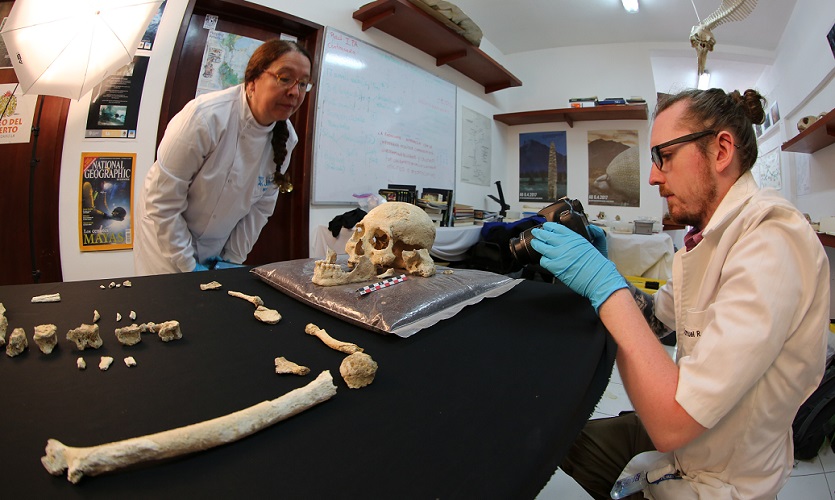Woman’s skeleton shines light on early peopling of the New World

A FEMALE skeleton found in Mexico has strengthened the theory that humans originally reached the American continent from different points of origin.
The Paleoindian human found on the Yucatán Peninsula is at least 10,000 years old and most likely dates from the end of the most recent ice age, the late Pleistocene. Paleoindians or Paleoamericans were the first peoples who entered, and subsequently inhabited, the Americas.
It was discovered by an international team including researchers from LJMU's School of Biological and Environmental Sciences.
The skeleton, discovered in the Chan Hol cave near the city of Tulúm which is now water-filled as the result of sea-level rise after the ice age, is described in the journal PLoS One by a team of scientists from the UK, Germany and Mexico. It was was identified as a woman, about 30 years of age, with multiple cranial traumas, which the woman may have survived.
The scientists have called the woman Ixel which is Mayan for Mother Earth.
The find brings to ten the count of human skeletons from the area which display round headed (mesocephalic) cranial characteristics different to the long-headed (dolicocephalic) morphology of Paleoindians from Central Mexico and North America with equivalent dates.
America settlement 'complicated'
“The Tulúm skeletons may indicate that either, more than one group of humans originally reached the American continent from different geographical points of origin, or that there was sufficient time for a small group of early settlers living in isolation on the Yucatán Peninsula, to develop a different skull morphology,” explains Silvia Gonzalez, Professor of Quaternary Geology and Geoarchaeology at Liverpool John Moores University,
“In either case, the early settlement history of the Americas appears to be more complicated and may date back thousands of years earlier than commonly believed, according to the new human morphology data”, says Prof Gonzalez.
The team, led by Professor Wolfgang Stinnesbeck, an earth scientist at Heidelberg University, dated the woman’s remains using rock-hard flowstone that covered some finger bones. Stinnesbeck explains that conventional radiocarbon dating methods were not effective because collagen in the bones had been completely washed out due to the long period spent in water.
By using uranium-thorium isotopes of a flowstone that had grown on finger bones in the originally dry Chan Hol Cave, they were able to give the skeleton a minimum age of 9,900 years. However, the body was then already skeletonized and may be older.
More human remains
In 2017, the researchers had already documented another human skeleton from Chan Hol cave, which was then considered to be 13,000 years old. While this earlier find would clearly be one of the oldest human skeletons from the Americas, the new skeleton may be of similar age.
Added Dr Sam Rennie a former PhD paleoanthropologist from Liverpool John Moores University: “The skull also presents evidence for a bacterial treponemal infection that caused severe alteration of cranial bones. This is the first time that the presence of such a disease is reported in a Paleoindian skeleton in the Americas.”
ends
New Publication:
Stinnesbeck, W., Rennie, S.R., Avilés Olguín, J., Stinnesbeck, S.R., González, S., Frank, N., Warken, S., Schorndorf, N., Krengel, T., Velázquez Morlet, A., and González González, A.H. (2020): New evidence for an early settlement of the Yucatán Peninsula, Mexico: The Chan Hol 3 woman and her meaning for the Peopling of the Americas. PlosOne
Earlier Publication: W. Stinnesbeck, J. Becker, E. Frey, E.A. González, J. Fohlmeister, S. Stinnesbeck, N. Frank, A. Terrazas Mata, M.E. Benavente, J. Avilés, E. Aceves Nunez, Zell, P. & M. Deininger (2017): The Earliest Settlers of Mesoamerica date back to the late Pleistocene. PlosOne, 2017, 12 (8): e0183345 DOI: 10.1371/journal.pone.0183345
Contacts:
General Project information: Prof. Silvia Gonzalez S.Gonzalez@ljmu.ac.uk 0151 231 2213
Additional information:
On osteology and pathologies: Dr Samuel Rennie srrennie90@icloud.com
Early Peopling of the Americas and its importance for Mexico: Prof Silvia González (Liverpool John Moores University, UK): S.Gonzalez@ljmu.ac.uk and Arturo González (Museo del Desierto, Saltillo, Mexico): arteconciencia2@gmail.com
On cave diving operations: Jerónimo Avilés Olguín (Solidaridad, Mexico): subfilms@yahoo.com
On dating techniques: Dr Norbert Frank (Heidelberg, Germany): Norbert.Frank@iup.uni-heidelberg.de
Pictures: Jerónimo Avilés Olguín


